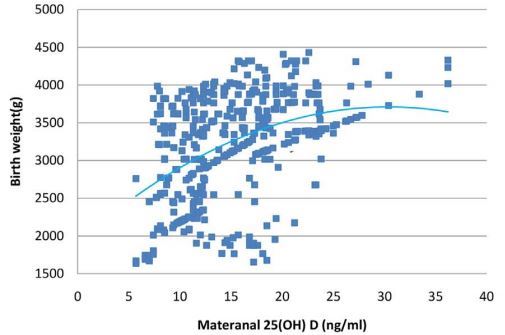Risk a small infant (SGA) increased by 9 percent for every ng lower vitamin D
Maternal early pregnancy vitamin D status in relation to low birth weight and small-for-gestational-age offspring.
J Steroid Biochem Mol Biol. 2017 Sep 19. pii: S0960-0760(17)30258-3. doi: 10.1016/j.jsbmb.2017.09.010. [Epub ahead of print]
Wang H1, Xiao Y2, Zhang L1, Gao Q1.
1 Department of Pediatric, the Second Hospital of Xi'an Jiao Tong University, Xi'an, China.
2 Department of Pediatric, the Second Hospital of Xi'an Jiao Tong University, Xi'an, China. Xiaoyfxju29@163.com.
Vitamin D vs SGA risk

Vitamin D vs Birth Weight

Maternal vitamin D deficiency is an independent risk factor for fetal growth. We examined the associations between maternal vitamin D status (defined by 25-hydroxyvitamin D [25(OH)D]) at the first prenatal visit and measures of newborn and placental weight, in a large China cohort of singleton, term, live births. From July 2015 to June 2016, women delivering singleton, term, live births with 25(OH)D measured at a first prenatal visit (N=747). Birth weight, placental weight, the placental to fetal weight ratio, and small for gestational age (SGA) were measured. The relationship between levels of 25(OH)D and SGA were evaluated using univariate and multivariate regression analysis. Vitamin D deficiency was defined as 25(OH)D less than 20 ng/ml. In those women, 76.9% (95%CI: 74%-78%) were defined as vitamin D deficiency. Incidence of SGA was also high (13.3%; 95%CI: 10.8%-15.7%).
We found a nonlinear relation between 25(OH)D and birth weight as well as head circumference (P <0.01).
Birth weight and head circumference increased by 69 [95%CI: 38-122] g and 0.31 (0.22-0.40) cm, respectively, per 1ng/ml increase in maternal 25(OH)D up to 20 ng/ml and then leveled off thereafter.
The SGA distribution across the 25(OH)D quartiles ranged between 3.7% (fourth quartile) to 24.1% (first quartile).
For each 1 unit decrease of plasma concentration of 25(OH)D, the unadjusted and adjusted risk of SGA increased by 19% (odds ratio 1.19 [95% CI 1.13-1.25], P <0.001) and 9% (1.08 [1.03-1.16], P=0.009), respectively.
In a multivariate model using the vitamin D deficiency vs. other together with the clinical variables, the adjusted risk of SGA increased by 205% (odds ratio 3.05 [95% CI 2.24-4.40], P=0.001). Maternal vitamin D insufficiency is common during pregnancy and is independently associated with low birth weight and high risk of SGA in term infants.
PMID: 28939424 DOI: 10.1016/j.jsbmb.2017.09.010
